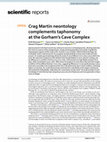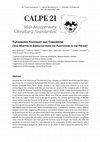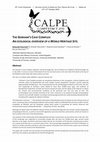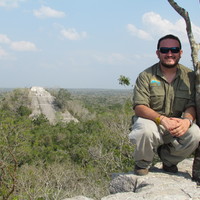Books by Tyson L Holmes
Gib-Bats, 2014
A short introduction to the bats of Gibraltar.
Book chapters by Tyson L Holmes
Ice Age Europe Magazine, 2018
Gibraltar has long been renowned in palaeontology circles for the two well known Neanderthal skul... more Gibraltar has long been renowned in palaeontology circles for the two well known Neanderthal skull fossils discovered at the foot of the Rock in the 19th and 20th centuries. This article describes the journey that led to the discovery of the third Neanderthal fossil from the recently inscribed UNESCO World Heritage Site in Gibraltar - a 50,000 year-old milk tooth from Vanguard Cave.
Ice Age Europe Magazine, 2017
The Gorham's Cave Complex in Gibraltar is of major significance in understanding the global human... more The Gorham's Cave Complex in Gibraltar is of major significance in understanding the global human journey. This article summarises the Outstanding Universal Value of a Neanderthal site which in 2016 made it onto UNESCO's List of World Heritage Sites.
La ocupación durante la Prehistoria Reciente de las cavidades gibraltareñas es un tema que debido... more La ocupación durante la Prehistoria Reciente de las cavidades gibraltareñas es un tema que debido a diversas razones ha pasado inadvertido a la historiografía regional; Excavaciones antiguas seguidas de años con intervenciones no sistemáticas han deparado una pérdida de importante información hasta la llegada del Gibraltar Caves Project. Con este trabajo pretendemos paliar, en la medida de lo posible, este vacío de estudios, presentando las cavidades que con fines sepulcrales proponemos, se ocuparon en Gibraltar durante la Prehistoria Reciente.
Papers by Tyson L Holmes

Scientific Reports, 2021
Species present in the fossil record may continue to exist at an archaeological site, allowing st... more Species present in the fossil record may continue to exist at an archaeological site, allowing study that fine-tunes our picture of the ecological past. A large wintering population of Eurasian Crag Martins Ptyonoprogne rupestris (ECM) roosts at the ‘Gorham’s Cave Complex’ UNESCO World Heritage site in Gibraltar, which is best known for its occupation by Neanderthals at times when ECMs were also present. Its complex geomorphology allows the study of use of different micro-sites (caves) within the roost. We used mark-recapture to test whether birds showed fidelity to micro-sites for roosting, and for differences in condition of birds across micro-sites. ECM showed very high fidelity towards micro-sites, within and between years, with > 90% chance of recapture at caves where they were first caught. Condition of birds differed between micro-sites, suggesting differences in roost quality between caves; birds were more likely to be recaptured at the micro-site where birds were in best...
La ocupación durante la Prehistoria Reciente de las cavidades gibraltareñas es un tema que debido... more La ocupación durante la Prehistoria Reciente de las cavidades gibraltareñas es un tema que debido a diversas razones ha pasado inadvertido a la historiografía regional; Excavaciones antiguas seguidas de años con intervenciones no sistemáticas han deparado una pérdida de importante información hasta la llegada del Gibraltar Caves Project. Con este trabajo pretendemos paliar, en la medida de lo posible, este vacío de estudios, presentando las cavidades que con fines sepulcrales proponemos, se ocuparon en Gibraltar durante la Prehistoria Reciente.
PLOS ONE
We tracked pallid swifts (Apus pallidus brehmorum) from a single breeding colony in Gibraltar ove... more We tracked pallid swifts (Apus pallidus brehmorum) from a single breeding colony in Gibraltar over two years. Our results show movement of birds between specific regions within the non-breeding geographical area at specific times of the year. The tracking of a single individual showed remarkable fidelity to the areas visited between years. Furthermore, two pallid swifts tracked over the entire eight-month non-breeding period, while in Africa, gave no indication of coming to land, supporting previous findings of an airborne existence in swifts outside the breeding season. In addition, the crossing of the Sahara Desert to and from breeding grounds is remarkably fast, with one individual crossing it in just over a day. We discuss our findings in the context of bird migration evolutionary strategies.

arXiv: Populations and Evolution, 2020
Understanding the behaviour of hosts of SARS-CoV-2 is crucial to our understanding of the virus. ... more Understanding the behaviour of hosts of SARS-CoV-2 is crucial to our understanding of the virus. A comparison of environmental features related to the incidence of SARS-CoV-2 with those of its potential hosts is critical. We examine the distribution of coronaviruses among bats. We analyse the distribution of SARS-CoV-2 in a nine-week period following lockdown in Italy, Spain, and Australia. We correlate its incidence with environmental variables particularly ultraviolet radiation, temperature, and humidity. We establish a clear negative relationship between COVID-19 and ultraviolet radiation, modulated by temperature and humidity. We relate our results with data showing that the bat species most vulnerable to coronavirus infection are those which live in environmental conditions that are similar to those that appear to be most favourable to the spread of COVID-19. The SARS-CoV-2 ecological niche has been the product of long-term coevolution of coronaviruses with their host species. ...
PLoS ONE, 2021
We tracked pallid swifts (Apus pallidus brehmorum) from a single breeding colony in Gibraltar ove... more We tracked pallid swifts (Apus pallidus brehmorum) from a single breeding colony in Gibraltar over two years. Our results show movement of birds between specific regions within the non-breeding geographical area at specific times of the year. The tracking of a single individual showed remarkable fidelity to the areas visited between years. Furthermore, two pallid swifts tracked over the entire eight-month non-breeding period, while in Africa, gave no indication of coming to land, supporting previous findings of an airborne existence in swifts outside the breeding season. In addition, the crossing of the Sahara Desert to and from breeding grounds is remarkably fast, with one individual crossing it in just over a day. We discuss our findings in the context of bird migration evolutionary strategies.

Scientific Reports, 2021
Species present in the fossil record may continue to exist at an archaeological site, allowing st... more Species present in the fossil record may continue to exist at an archaeological site, allowing study that fine-tunes our picture of the ecological past. A large wintering population of Eurasian Crag Martins Ptyonoprogne rupestris (ECM) roosts at the 'Gorham's Cave Complex' UNESCO World Heritage site in Gibraltar, which is best known for its occupation by Neanderthals at times when ECMs were also present. Its complex geomorphology allows the study of use of different micro-sites (caves) within the roost. We used mark-recapture to test whether birds showed fidelity to micro-sites for roosting, and for differences in condition of birds across micro-sites. ECM showed very high fidelity towards microsites, within and between years, with > 90% chance of recapture at caves where they were first caught. Condition of birds differed between micro-sites, suggesting differences in roost quality between caves; birds were more likely to be recaptured at the micro-site where birds were in best condition, indicating higher survivorship. Our results demonstrate extremely fine-scale fidelity at the largest roosting site documented for ECM globally. Implications for conservation are discussed. The study provides current knowledge of a bird that has been using these caves since the Pleistocene and more generally on these caves as refuges.

arXiv.org, 2020
Understanding the behaviour of hosts of SARS-CoV-2 is crucial to our understanding of the virus. ... more Understanding the behaviour of hosts of SARS-CoV-2 is crucial to our understanding of the virus. A comparison of environmental features related to the incidence of SARS-CoV-2 with those of its potential hosts is critical. We examine the distribution of coronaviruses among bats. We analyse the distribution of SARS-CoV-2 in a nine-week period following lockdown in Italy, Spain, and Australia. We correlate its incidence with environmental variables particularly ultraviolet radiation, temperature, and humidity. We establish a clear negative relationship between COVID-19 and ultraviolet radiation, modulated by temperature and humidity. We relate our results with data showing that the bat species most vulnerable to coronavirus infection are those which live in environmental conditions that are similar to those that appear to be most favourable to the spread of COVID-19. The SARS-CoV-2 ecological niche has been the product of long-term coevolution of coronaviruses with their host species. Understanding the key parameters of that niche in host species allows us to predict circumstances where its spread will be most favourable. Such conditions can be summarised under the headings of nocturnality and seasonality. High ultraviolet radiation, in particular, is proposed as a key limiting variable. We therefore expect the risk of spread of COVID-19 to be highest in winter conditions, and in low light environments. Human activities resembling those of highly social cave-dwelling bats (e.g. large nocturnal gatherings or high density indoor activities) will only serve to compound the problem of COVID-19.
Conference Presentations by Tyson L Holmes
Presentation given to the Friends of Gibraltar Heritage Society (FOGHS) following the successful ... more Presentation given to the Friends of Gibraltar Heritage Society (FOGHS) following the successful application for the 2020 PhD research bursary from the FOGHS.

Gibraltar has a rich fossil record. The Gorham’s Cave Complex is a UNESCO World Heritage Site tha... more Gibraltar has a rich fossil record. The Gorham’s Cave Complex is a UNESCO World Heritage Site that is best known for its occupation by Neanderthals, but many other species are documented to have been present alongside them. Some species present in the fossil record may continue to exist at an archaeological site, allowing study that can fine-tune our picture of the ecological past. In Gibraltar these include the Eurasian Crag Martin Ptyonoprogne rupestris (ECM), a large wintering population of which roosts at the Gorham’s Cave Complex. The roost was first documented in the 18th Century and it was studied during the late 20th Century. Work since 2016 has included counts that have revealed this to be the largest known roost of the species globally. The complex geomorphology of the site allows further study that focusses on the species’ ecology, in particular the use of different micro-sites (caves) within the roost. We used mark-recapture to test whether birds showed fidelity to micro-sites for roosting. We also tested for differences in condition of birds across micro-sites. ECM showed very high fidelity towards micro-sites, within and between years. Furthermore, condition of birds differed between micro-sites, suggesting differences in roost quality between caves: birds were more likely to be recaptured at the micro-site where birds were in best condition, indicating higher survivorship. Our results demonstrate extremely fine-scale fidelity at the largest roosting site documented for ECM globally, but more generally, the study provides current knowledge of a bird that has been using these caves since the Pleistocene and more generally on these caves as refuges. Our results also offer the possibility to serve as a model for a new approach to the examination of other extant species with a similar chronological background, when these can be shown to have a sustained relationship with a particular site.

17th Calpe Conference: Caves as Archives, 2013
The Gibraltar Caves Project commenced in 1989. During this time our knowledge of Gibraltar’s cave... more The Gibraltar Caves Project commenced in 1989. During this time our knowledge of Gibraltar’s caves has increased significantly. In this presentation we will focus on the historical and biological aspects of Gibraltar’s caves. If some of these caves are unique archives, as will become apparent in this conference, then we should consider Gibraltar’s caves in their entirety to constitute a Grand Reference Library. Our presentation will commence with a historical summary of the work which has been undertaken and will include examples of the pioneering work that was carried out, particularly during the 1990s, with specific case studies as examples. The second part of the presentation will focus on the work at Gorham’s and Vanguard Caves as an example of a long-term research project that has proceeded uninterrupted since 1991. This part of the presentation will illustrate the richness of the cave archives at Gorham’s and Vanguard Caves with specific examples that show how the information from these archives can inform about the lives of the people who lived here in the remote past. The third part will bring the work of the Gibraltar Caves Project, and specifically that of the Gibraltar Museum’s Caving Unit, to the present. We will briefly review earlier work done during the 18th and 20th centuries. An up-to-date inventory of Gibraltar’s caves will be presented. In addition, examples of how historical material can help us understand aspects of our caves will be presented. The overall message of our presentation is twofold: (a) Gibraltar’s caves constitute a Grand Reference Library. There is no other place on Earth with such a wealth. They deserve to form part of a Gibraltar Geopark; (b) The Grand Reference Library requires strict protection. The ultimate message of this presentation is one of conservation. We need to ensure that all our caves are protected by legislation and appropriate management plans and that all our caves are treated with the due respect that they deserve.

7th SECEMU Conference on Bat Research and Conservation, 2018
Gibraltar is a small country near the southernmost tip of the Iberian Peninsula bordering Spain. ... more Gibraltar is a small country near the southernmost tip of the Iberian Peninsula bordering Spain. Covering an area of just 7km2, most of the territory is dominated by the famous Rock of Gibraltar, a monolithic Jurassic limestone promontory rising 426m above the Mediterranean Sea. Riddled with over 200 recorded natural caves and 55km of tunnels, Gibraltar is the perfect roosting habitat for bats. Or at least it once was… The first bat census records for Gibraltar dating from the 1960s-70s account for over 36,000 bats, mostly of two cave-dwelling species – the Schreibers’ bat (Miniopterus schreibersii) and the Greater Mouse-Eared bat (Myotis myotis). These censuses were not scientific in nature and carried out by non-specialists but nevertheless mark the origins of bat conservation in Gibraltar. Following the founding of the Gibraltar Ornithological and Natural History Society in 1976, its Mammal Section eventually took over responsibility for safeguarding the future of bats on the Rock. However, their records already showed a sharp decline in numbers from those previously recorded which is corroborated by correspondence from visiting bat specialists from the United Kingdom in the 1980s-90s. Links with the Bat Conservation Trust where later established. The Gib-Bats project was created in 2013 as a collaborative study which sought to identify all bat species found on the Rock as well as their roosts in order to better understand their ecology, with the ultimate aim of developing a national conservation strategy for bats. Initial findings have shown that up to seven different species are currently found in Gibraltar, some previously unrecorded on the Rock. However, four species have become locally extinct and populations have crashed with an alarming 97% decline since records began. The reasons for this decline range in complexity and these need to be studied in detail if the remaining populations are to survive.

24th Calpe Conference - Natural History of Gibraltar: Past, Present & Future, 2020
Riddled with over 200 recorded natural caves and 55km of tunnels, the Rock of Gibraltar presents ... more Riddled with over 200 recorded natural caves and 55km of tunnels, the Rock of Gibraltar presents the perfect roosting habitat for bats. Or at least it once did… The first bat census records for Gibraltar dating from the 1960s-70s account for over 36,000 bats, mostly dominated by two cave-dwelling species: The Schreibers' bat (Miniopterus schreibersii) and the Greater Mouse-Eared bat (Myotis myotis). These censuses were not scientific in nature and carried out by non-specialists but nevertheless mark the origins of bat conservation in Gibraltar. Following the founding of the Gibraltar Ornithological and Natural History Society in 1976, its Mammal Section eventually took over responsibility for safeguarding the future of bats on the Rock. However, their records already showed a sharp decline in numbers from those previously recorded which is corroborated by correspondence from visiting bat specialists from the United Kingdom in the 1980s-90s. Links with the Bat Conservation Trust (UK) where later established. The Gib-Bats Project was created in 2013 as a collaborative study which sought to identify all bat species found on the Rock as well as their roosts and feeding grounds in order to better understand their ecology, with the ultimate aim of developing a national conservation strategy for bats. We report that our Initial findings have shown that up to seven different species currently occur in Gibraltar, some previously unrecorded on the Rock. However, other species have become locally extinct and populations have crashed with an alarming 97% decline since records began. We outline the reasons for this decline, which range in complexity and require further research if the remaining populations are to survive into the future. In the second half of our presentation, we discuss our current research projects in the region and conclude with questions on the future prospects of bat conservation in Gibraltar.

24th Calpe Conference - Natural History of Gibraltar: Past, Present & Future, 2020
The Gorham's Cave Complex, Gibraltar's World Heritage Site, was inscribed on to UNESCO's World He... more The Gorham's Cave Complex, Gibraltar's World Heritage Site, was inscribed on to UNESCO's World Heritage List in July 2016. It covers an area of 28 hectares from the sea level caves on the east side of the Rock to the top of the Mediterranean Steps 426 metres above sea level. The site is inscribed under UNESCO's cultural Criterion (iii): "Gorham's Cave Complex provides an exceptional testimony to the occupation, cultural traditions and material culture of Neanderthal and early modern human populations through a period spanning approximately 120,000 years. This is expressed by the rich archaeological evidence in the caves, the rare rock engravings at Gorham's Caves (dated to more than 39,000 years ago), rare evidence of Neanderthal exploitation of birds and marine animals for food, and the ability of the deposits to depict the climatic and environmental conditions of the peninsula over this vast span of time. The archaeological and scientific potential of the caves continues to be explored through archaeological research and scientific debates, providing continuing opportunities for understanding Neanderthal life, including their capacity for abstract thinking." The Statement continues: "...The attributes that express [Outstanding Universal Value] are the striking cluster of caves containing intact archaeological deposits that provide evidence of Neanderthal and early modern human occupation of Gibraltar and the landscape setting which assists in presenting the natural resources and environmental context of Neanderthal life..." (Statement of OUV, July 2016). Although inscribed under the UNESCO cultural criteria, the World Heritage Site also contains unique topography and geological features, as well as natural cliff vegetation and rocky shoreline communities, which are known to have existed at the time of the Neanderthals. The evidence of the relationship of the Neanderthals and their environment can be clearly seen in this site. Part of this landscape was subjected to irreversible change with sea level rise 10,000 years ago; ancient raised beaches, scree slopes, shorelines and dunes within the site are reminders of the dynamic and precarious nature of a coastal world that was in a constant state of flux. The incomparable topography of the Rock of Gibraltar, as well as its modern-day flora and fauna, with many species still present from ancient times, opens up an exclusive window into the lost world of the Neanderthals. This paper will consider the environment of the Neanderthals and the exceptional and vivid picture that can be built from the evidence provided by this World Heritage Site.
Friends of Gibraltar Heritage Society seminar, University of Gibraltar, 2020
Presentation given to the Friends of Gibraltar Heritage Society (FOGHS) following the successful ... more Presentation given to the Friends of Gibraltar Heritage Society (FOGHS) following the successful application for the 2020 PhD research bursary from the FOGHS.











Uploads
Books by Tyson L Holmes
Book chapters by Tyson L Holmes
Papers by Tyson L Holmes
Conference Presentations by Tyson L Holmes